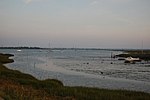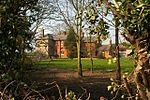Goldhanger

Goldhanger is a village and a civil parish on the B1026 road in the Maldon District, in the English county of Essex. Goldhanger had an agricultural museum and has a church dedicated to St Peter. Goldhanger is at the head of a short creek, on the north side of the estuary of the River Blackwater, 4 miles (6.4 km) east northeast of the town of Maldon. There are eight roads in Goldhanger: Head Street, Fish Street, Church Street, St Peter's Close, Maldon Road, Hall Estate, Sorrell Close, and finally Blind Lane. The village is directly between Maldon and Tolleshunt D'Arcy and also has direct passage to the River Blackwater. The place-name Goldhanger is first attested in the Domesday Book of 1086, where it appears as Goldhangra. The name means 'slope where marigold grew', from the Old English golde meaning marigold.
Excerpt from the Wikipedia article Goldhanger (License: CC BY-SA 3.0, Authors, Images).Goldhanger
Church Street, Essex
Geographical coordinates (GPS) Address Nearby Places Show on map
Geographical coordinates (GPS)
| Latitude | Longitude |
|---|---|
| N 51.7455 ° | E 0.7581 ° |
Address
Church Street
CM9 8AS Essex, Goldhanger
England, United Kingdom
Open on Google Maps









